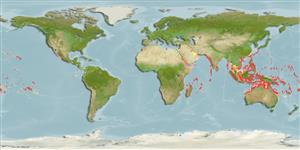分類 / Names
俗名 | 同種異名 | Catalog of Fishes(屬, 種) | ITIS | CoL | WoRMS | Cloffa
Teleostei >
Kurtiformes (Nurseryfishes, cardinalfishes.)
鱸形目 (Nurseryfishes, cardinalfishes.) >
Apogonidae (Cardinalfishes)
天竺鯛科 (Cardinalfishes) > Apogoninae
More on author: Lachner.
Environment: milieu / climate zone / 深度上下限 / distribution range
生態學
海洋 礁區魚類; 深度上下限 3 - 50 m (Ref. 90102). 熱帶; 30°N - 30°S
Western Indian Ocean: Mozambique (Ref. 41878), Red Sea and Christmas Island to the Tuamoto Islands, north to southern Japan, south to New Caledonia and Rapa.
印度-太平洋: 已知只來自紅海與印度洋的聖誕島了; 範圍到 Tuamoto 島, 北至日本南部, 南至新加勒多尼亞與拉帕島。 西印度洋: 莫三比克.(參考文獻 41878)
大小 / 重量 / 年齡
成熟度: Lm ? range ? - ? cm
Max length : 10.0 cm TL 雄魚/尚未辨別雌雄; (Ref. 2334); common length : 7.0 cm SL 雄魚/尚未辨別雌雄; (Ref. 37816)
背棘 (總數) : 8; 背的軟條 (總數) : 9; 臀棘: 2; 臀鰭軟條: 8. Characterized by having dorsal fin rays VII-I, 9; anal fin rays II,8; pectoral fin rays 14; pelvic fin rays I, 5; pored lateral line scales 24; predorsal scales 4; circumpeduncular scales 12; total gill rakers 24, developed gill rakers 18; snout pointed; body white in color (Ref. 93839). Further characterized by alternating black and yellow stripes, dark stripes wider; greatest depth of body 2.6-3.1 in SL (Ref. 90102).
Body shape (shape guide): elongated; Cross section: compressed.
身體有 5 寬的全深褐色的到黑色的斑紋 (佈滿了紅色), 在尾部的基底末端形成一個深色的斑點的一個側面中央的。 嘴斜角; 前面的前鰓蓋骨邊緣平滑的, 在後部的鋸齒狀的。
Occurs on reef flats and shallow lagoon reef, usually seen singly or in pairs under ledges or in crevices. Feed on small benthic invertebrates at night (Ref. 2141).
生活於礁石平臺與水淺的潟湖礁, 通常各別地見到或成對岩架下或在裂隙中。 捕食小型底棲的無脊椎動物在晚上。 (參考文獻 2141)
Life cycle and mating behavior
成熟度 | 繁殖 | 產卵場 | 卵 | 孕卵數 | 仔魚
Mouthbrooders (Ref. 240). Distinct pairing during courtship and spawning (Ref. 205).印度-太平洋: 已知只來自紅海與印度洋的聖誕島了; 範圍到 Tuamoto 島, 北至日本南部, 南至新加勒多尼亞與拉帕島。 西印度洋: 莫三比克.(參考文獻 41878)
Randall, J.E. and E.A. Lachner, 1986. The status of the Indo-West Pacific cardinalfishes Apogon aroubiensis and A. nigrofasciatus. Proc. Biol. Soc. Wash. 99(1):110-120. (Ref. 2141)
IUCN 瀕危狀態 (Ref. 130435: Version 2024-2)
無危 (LC) ; Date assessed: 10 December 2020
人類使用
工具
特別的報告
下載 XML
網路資源
Estimates based on models
Preferred temperature (參考文獻
123201): 25.4 - 28.9, mean 27.7 °C (based on 594 cells).
Phylogenetic diversity index (參考文獻
82804): PD
50 = 0.5000 [Uniqueness, from 0.5 = low to 2.0 = high].
Bayesian length-weight: a=0.00794 (0.00407 - 0.01549), b=3.34 (3.17 - 3.51), in cm total length, based on LWR estimates for this species & (Sub)family-body (Ref.
93245).
營養階層 (參考文獻
69278): 3.6 ±0.4 se; based on diet studies.
回復力 (參考文獻
120179): 高度, 族群倍增時間少於 15個月 (Preliminary K or Fecundity.).
Fishing Vulnerability (Ref.
59153): Low vulnerability (10 of 100).
🛈
Nutrients (Ref.
124155): Calcium = 163 [86, 282] mg/100g; Iron = 0.969 [0.554, 1.636] mg/100g; Protein = 18.5 [17.4, 19.6] %; Omega3 = 0.112 [0.062, 0.207] g/100g; Selenium = 37 [17, 80] μg/100g; VitaminA = 83.8 [26.8, 256.6] μg/100g; Zinc = 2.02 [1.31, 2.97] mg/100g (wet weight);
